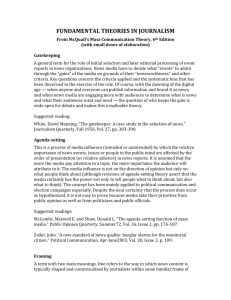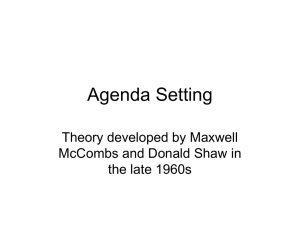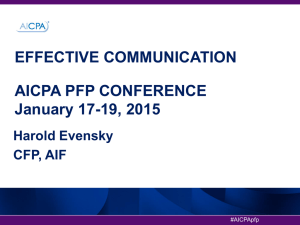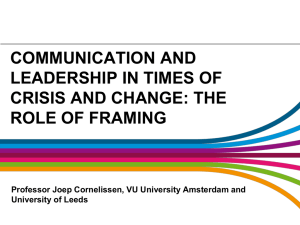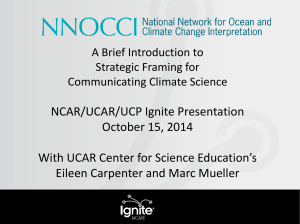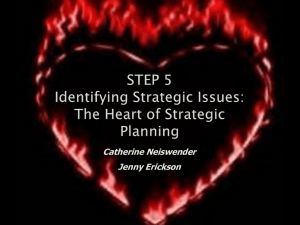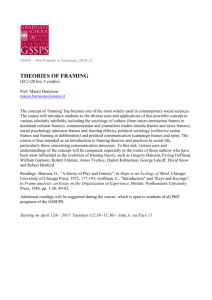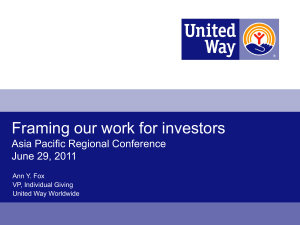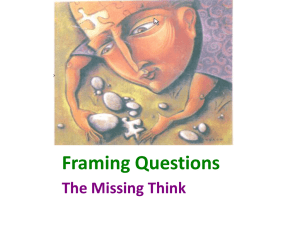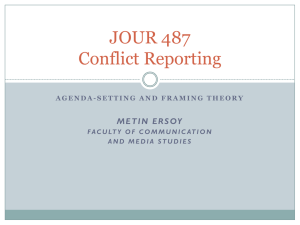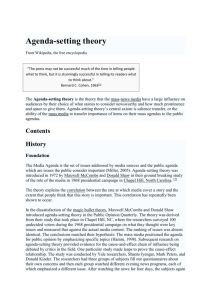Sample reading lists
advertisement
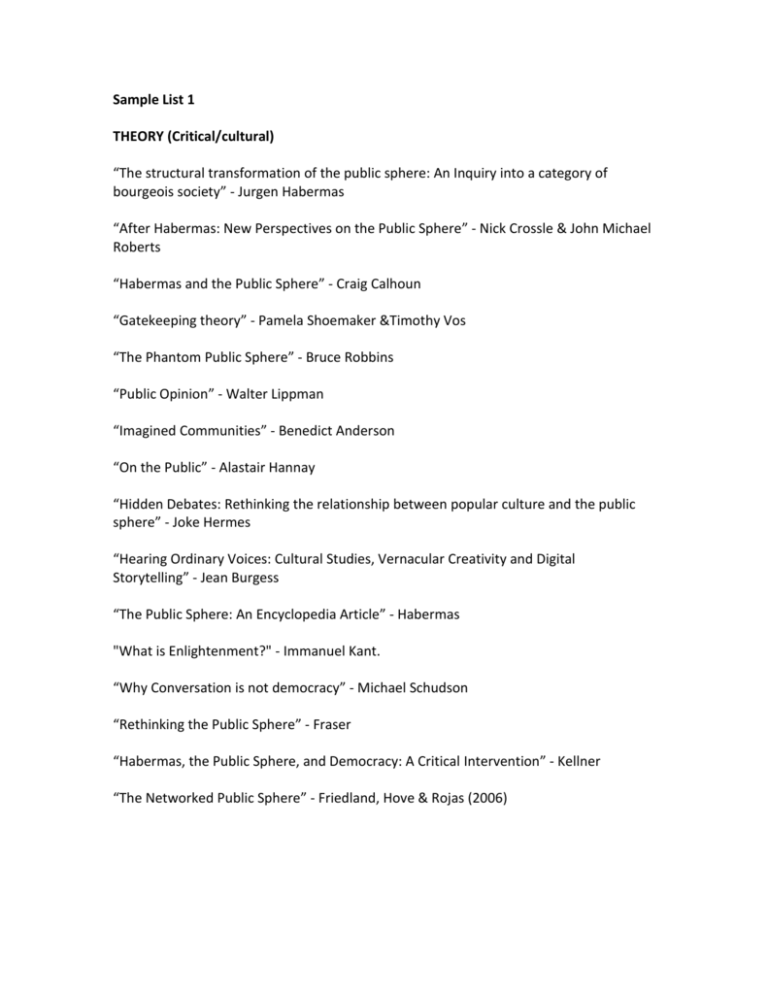
Sample List 1 THEORY (Critical/cultural) “The structural transformation of the public sphere: An Inquiry into a category of bourgeois society” - Jurgen Habermas “After Habermas: New Perspectives on the Public Sphere” - Nick Crossle & John Michael Roberts “Habermas and the Public Sphere” - Craig Calhoun “Gatekeeping theory” - Pamela Shoemaker &Timothy Vos “The Phantom Public Sphere” - Bruce Robbins “Public Opinion” - Walter Lippman “Imagined Communities” - Benedict Anderson “On the Public” - Alastair Hannay “Hidden Debates: Rethinking the relationship between popular culture and the public sphere” - Joke Hermes “Hearing Ordinary Voices: Cultural Studies, Vernacular Creativity and Digital Storytelling” - Jean Burgess “The Public Sphere: An Encyclopedia Article” - Habermas "What is Enlightenment?" - Immanuel Kant. “Why Conversation is not democracy” - Michael Schudson “Rethinking the Public Sphere” - Fraser “Habermas, the Public Sphere, and Democracy: A Critical Intervention” - Kellner “The Networked Public Sphere” - Friedland, Hove & Rojas (2006) Sample List 2 THEORY (Selective Exposure, Spiral of Silence, Third Person Effect, Hostile Media Effect) Cotton, J. L. (1985). Cognitive dissonance in selective exposure. In D. Zillmann & J. Bryant (Eds.), Selective exposure to communication (pp. 11-33). Hillsdale: Erlbaum. Festinger, L. A. (1957). A Theory of Cognitive Dissonance. Stanford, CA: Stanford University Press Feldman, L., & Price, V. (2008). Confusion or enlightenment? How exposure to disagreement moderates the effects of political discussion and media use on candidate knowledge. Communication Research, 35(1), 61-87 Freedman, J. L. (1965a). Confidence, utility, and selective exposure. Journal of Personality & Social Psychology, 2(5), 778-780. Freedman, J. L. (1965b). Preference for dissonant information. Journal of Personality & Social Psychology, 2(2), 287-289. Frey, D. (1986). Recent research on selective exposure to information. In L. Berkowitz (Ed.), Advanced in Experimental Social Psychology (pp. 41-80). New York: Academic Press. Garrett, R. K. (2009a). Echo chambers online? Politically motivated selective exposure among Internet news users. Journal of Computer Mediated Communication, 14, 265-285. Garrett, R. K. (2009b). Politically motivated reinforcement seeking: Reframing the selective exposure debate. Journal of Communication, 59, 676-699. Iyengar, S., Hahn, K. S., Krosnick, J. A., & Walker, J. (2008). Selective exposure to campaign communication: The role of anticipated agreement and issue public membership. Journal of Politics, 70(1), 186-120. Iyengar, S. (1990). Shortcuts to political knowledge: The role of selective attention and accessibility. In J. A. Ferejon & J. H. Kuklinski (Eds.), Information and democratic processes (pp. 160-185). Urbana: University of Illinois Press. Kim, Y. M. (2007). How intrinsic and extrinsic motivations interact in selectivity: Investigating the moderating effects of situational information processing goals in issue publics' Web behavior. Communication Research, 34(2), 185-211 Knobloch-Westerwick, S., & Meng, J. (2009). Looking the other way: Selective exposure to attitudeconsistent and counterattitudinal political information. Communication Research, 36(3), 426-448. Mutz, D. C. (2002a). The consequences of cross-cutting networks for political participation. American Journal of Political Science, 46, 838-855. Mutz, D. C. (2002b). Cross-cutting networts: Testing democracy theory in practice. American Political Science Review, 96, 111-126. Mutz, D. C., & Martin, P. S. (2001). Facilitating communication across lines of political difference. The American Political Science Review, 95, 97-114. Sears, D. O., & Freedman, J. L. (1967). Selective exposure to information: A critical review. Public Opinion Quarterly, 31, 194-213. Stroud, N. J. (2008). Media use and political predispositions: Revisiting the concept of selective exposure. Political Behavior, 30, 341-366. Stroud, N. J. (2010). Polarization and partisan selective exposure. Journal of Communication, 60(3), 556-576 Wojcieszak, M. E., & Mutz, D. C. (2009). Online groups and political discourse: Do online discussion spaces facilitate exposure to political disagreement? Journal of Communication, 59, 40-56 Sample List 3 Theory (Agenda Setting) Golan, G., & Wanta, W. (2001). Second-level agenda setting in the New Hampshire primary: A comparison of coverage in three newspapers and public perceptions of candidates. Journalism & Mass Communication Quarterly, 78, 247-259. Huckins, K. (1999). Interest group influence on the media agenda: A case study. Journalism & Mass Communication Quarterly, 76, 76-86. Kim, S. H., Scheufele, D. A., & Shanahan, J. (2002). Think about it this way: Attribute agendasetting function of the press and the public’s evaluation of a local issue. Journalism & Mass Communication Quarterly, 79, 7-25. Kiousis, S., Bantinmaroudis, P., & Ban, H. (1999). Candidate image attributes: Experiments on the substantive dimension of second level agenda setting. Communication Research, 27, 414-428. Lopez-Escobar, E., & Llamas, J. P. (1998). Agenda setting and community consensus: First and second level effects. International Journal of Public Opinion Research, 10, 335349. McCombs, M. E., Llamas, J. P., Lopez-Escobar, E., & Rey, F. (1997). Candidate images in Spanish elections: Second-level agenda-setting effects. Journalism and Mass Communication Quarterly, 74, 703–716. McCombs, M. E., Lopez-Escobar, E., & Llamas, J. P. (2000). Setting the agenda of attributes in the 1996 Spanish general election. Journal of Communication, 50, 77-92. McCombs, M. E., Shaw, D. L., & Weaver, D. (1997). Communication and democracy: Exploring the intellectual frontiers in agenda-setting theory. Mahwah, NJ: Erlbaum. Scheufele, D. A., (2000). Agenda-setting, priming, framing revisited: Another look at cognitive effects of political communication. Mass Communication & Society, 3, 297316. Wanta, W., Golan, G., & Lee, C. (2004). Agenda-setting and international news: Media influence on public perceptions of foreign nations. Journalism & Mass Communication Quarterly, 81, 2, 364-377. Wanta, W. (1988). The effects of dominant photographs: An agenda-setting experiment. Journalism Quarterly, 65, 107-111. Weaver, D., McCombs, M., & Shaw, D. L., (2004). Agenda-setting research: Issues, attributes, and influences. In L. L. Kaid (Ed.), Handbook of political communication research (pp. 257-282). Mahwah, NJ: Lawrence Erlbaum Associates. Chang, Kuang-Kuo. "Auto Trade Policy and the Press: Auto Elite as a Source of the Media Agenda." J&MC Quarterly Vol. 76, No. 2, Summer 1999, 312-324 Coleman, Renita and Stephen Banning. "Network TV News' Affective Framing of the Presidential Candidates: Evidence for a Second-Level Agenda-Setting Effect Through Visual Framing." J&MC Quarterly Vol. 83, No. 2, Summer 2006, 313-328. Coleman, Renita and Maxwell McCombs. "The Young and Agenda-less? Exploring Age-Related Differences in Agenda Setting on the youngest Generation, Baby Boomers, and the Civic Generation." J&MC Quarterly Vol. 84, No. 3, Autumn 2007, 495-508. Entman, Robert M. "Framing Bias: Media in the Distribution of Power." Journal of Communication, 57 (2007): 163-173. Lee, Jae Kook. "The Effect of the Internet on Homogeneity of the Media Agenda: A Test of the Fragmentation Thesis." J&MC Quarterly Vol. 84, No. 4, Winter 2007, 745760. Lim, Jeongsub. "A Cross-Lagged Analysis of Agenda Setting Among Online News Media." J&MC Quarterly Vol. 83, No. 2, Summer 2006, 298-312. Lippmann, Walter. Public Opinion. New York: Macmillian, 1922. McCombs, Maxwell and Donald Shaw. "The Agenda-Setting Funcation of Mass Media." Public Opinion Quarterly, 36 (1972), 176-187. McCombs, Maxwell. Setting the Agenda: The Mass Media and Public Opinion. Cambridge: Polity Press, 2004. Reese, Stephen D., Oscar H. Gandy, and August E. Grant (eds.). Framing Public Life. Mahwah, NJ: Lawrence Erlbaum Associates, 2001. Roberts, Marilyn, Wayne Wanta and Tzong-Houng (Dustin) Dzwo. "Agenda-Setting and Issue Salience Online." Communication Research Vol. 29 (2002): 452-465. Scheufele, Dietram A. and David Tewksbury. "Framing, Agenda Setting, and Priming: The Evolution of Three Media Effects Models." Journal of Communication 57 (2007): 9-20. Song, Yonghoi. "Internet News Media and Issue Development: A case Study on the Roles of Independent Online News Services as Agenda-Builders for Anti-US Protests in South Korea." New Media & Society Vol. 9 (1): 71-92. Soroka, Stuart N. Agenda-Setting Dynamics in Canada. Vancouver: UBC Press, 2002. Takeshita, Toshio. "Agenda-Setting Effects of the Press in a Japanese Local Election." Studies of Broadcasting Vol. 29 (1993): 193-216. Takeshita, Toshio and Shunji Mikami. "How Did Mass Media Influence the Voters' Choice in the 1993 General Election in Japan?: A Study of Agenda Setting." Keio Communication Review Vol. 17 (1995): 27-41. Tan, Yue and David H. Weaver. "Agenda-Setting Effects Among the Media, the Public, and Congress, 1946-2004." J&MC Quarterly Vol. 84, No. 4, Winter 2007, 729-744. Van Gorp, Baldwin. "The Constructionist Approach to Framing: Bringing Culture Back In." Journal of Communication Vol. 57 (2007): 60-78. Wanta, Wayne and Y. Hu. "Time-Lag Differences in the Agenda Setting Process: An Examination of Five News Media." International Journal of Public Opinion Research Vol. 6 (1994): 225-240. Weaver, David H. "Thoughts on Agenda Setting, Framing, and Priming." Journal of Communication Vol. 57 (2007): 142-147. Sample List 4 Theory (Framing) Carragee, K., & Roefs, W. (2004). The neglect of power in recent framing research. Journal of communication, 54(2). 214-233. Coleman, R. & Banning, S. (2006) Network TV news’ affective framing of the presidential candidates: evidence for a second-level agenda-setting effect through visual framing. Journalism & mass communication quarterly, 83(2). 313- 328. D’Angelo, P. (2002). News framing as a multiparadigmatic research program: A response to Entman. Journal of communication, 52(4). 870-888. Entman, R. (1993). Framing: toward clarification of a fractured paradigm. Journal of communication, 43(4). 51-58. Gamson, W. (1989). News as framing. American behavioral scientist, 33(2). 157-161. Graber, D.A. (1984) Processing the news: how people tame the information tide. New York : Longman. Iorio, S. & Huxman, S. (1996) Media coverage of political issues and the framing of personal concerns. Journal of communication. 46(4). 97-115. Muthukumaraswamy, S.D. & Johnson, B.W. (2007) A dual mechanism neural framework for social understanding. Philosophical psychology, 20(1). 43-63. Pan, Z. & Kosicki, G. (1993) Framing analysis: An approach to news discourse. Political communication, 10. 55-75. Reese, S., Gandy, O., &Grant, A. (Eds). (2001) Framing public life: Perspectives on media and our understanding of the social world. Mahwah, N.J.: Erlbaum. Scheufele, B. (2004) Framing-effects approach: A theoretical and methodological critique. European journal of communications 29(4). 401-428. Scheufele, D. (1999). Framing as a theory of media effects. Journal of communication, 49(1). 103-122. Bystrom, D.G., Robertson, T.A., & Banwart, M.A. (2001). Framing the fight: An analysis of media coverage of female and male candidates in primary races for governor and U.S. Senate in 2000. American Behavioral Scientist. 44(12), 1999-2013. Kamhawi, R. & Grabe, E. (2008). Engaging the female audience: An evolutionary psychology perspective on gendered responses to news valence frames. Journal of Broadcasting and Electronic Media, 52(1), 33-51. Miller, A. & Ross, S.D. (2004). They are not us: Framing of American Indians by the Boston Globe. The Howard Journal of Communications, 15, 245259. Poindexter, P.M., Smith, L. & Heider, D. (2003). Race and ethnicity in local television news: Framing, story assignments, and source selections. Journal of Broadcasting & Electronic Media, 524-536. Iyengar, S. (1991). Is anyone responsible?: How television frames political issues. Chicago: University of Chicago. Reese, S. D. (2007). The framing project: A bridging model for media research revisited. Journal of Communication, 57(1), 148-154. Scheufele, D. A. (2000). Agenda-setting, priming, and framing revisited: Another look at cognitive effects of political communication Mass Communication & Society, 3(2&3), 297-316. Semetko, H. A., & Valkenburg, P. M. (2000). Framing European politics: A content analysis of press and television news. Journal of Communication, 50(2), 93108. Price, V., Tewksbury, D., & Powers, E. (1997). Switching trains of thought: The impact of news frames on readers' cognitive responses. Communication Research, 24(5), 481-506.
